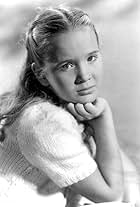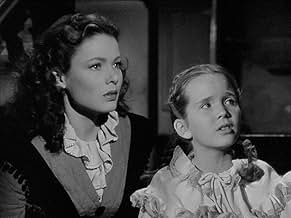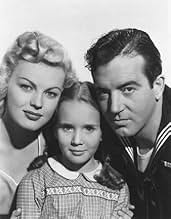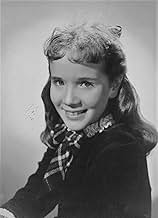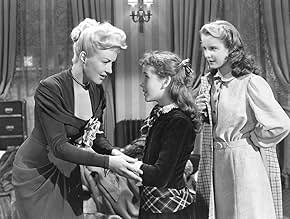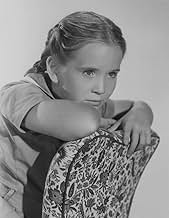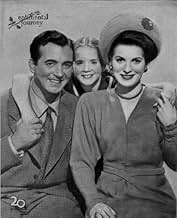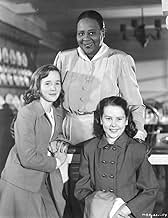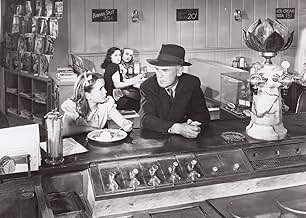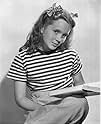Connie Marshall(1933-2001)
- Actress
- Soundtrack
A promising blue-to-gray-eyed, blonde-haired child actress of the post-WWII years who had more talent than she was given credit for,
little Constance Beekman "Connie" Marshall was born on April 28, 1933 in New York City. Her parents were not of show business stock, her father being a lieutenant with the Allied Military Government in Europe. She was a direct descent of this country's fourth Chief Justice, John Marshall, and was a descendant of Gerardus Beekman, the first Colonial Governor of New York.
Sensitive-looking and sad-eyed, Connie Marshall broke into the competitive side of show business quite young as a pig-tailed model for commercial newspapers and magazines. Frequently used by New York photographers, artists and caricaturists, she began her acting career a year later by happenstance. A failed screen test taken in Hollywood was, by luck, seen by 20th Century-Fox director Lloyd Bacon, who just happened to be casting the role of little Mary Osborne in the warm family comedy-drama, Sunday Dinner for a Soldier (1944). The film went on to star the future husband and wife team of Anne Baxter and John Hodiak, who first met and fell in love while shooting this picture. Director Bacon stopped looking when he came across young Connie.
Educated at the Gardner School in New York, where she appeared in a few plays, and the Fox Studio School, Connie also studied ballet and ballroom dancing. She made a strong impression in her very first film, with a natural forlorn ease as one of the Osborne children that also included up-and-coming Bobby Driscoll. With Connie's second picture Sentimental Journey (1946), she was handed her best weepy-eyed showcase. Terminally ill Julie Beck (played by Maureen O'Hara) adopts an orphan girl (played by Marshall) so Julie's husband, William (John Payne), will have someone to care for after she passes away. Connie held her own and received rave reviews.
She continued to show precocious promise in the post-war years in both sentimental drama and lightweight comedy with Dragonwyck (1946) as the daughter of Vincent Price; Home, Sweet Homicide (1946) as an amateur young sleuth who tries to solve a neighborhood murder aided by brother and sister Peggy Ann Garner and Dean Stockwell; Mother Wore Tights (1947) as the daughter of song-and-dance team Betty Grable and Dan Dailey; and the noted comedy classic, Mr. Blandings Builds His Dream House (1948) as the elder daughter of the titular couple, Mr. and Mrs. Blandings (played by, respectively, Cary Grant and Myrna Loy). She would work with the silver screen's top movie stars over the years, including Gene Tierney and Joan Crawford, but once she outgrew her precociousness, her career began to fade away. She attempted TV with the short-lived series Doc Corkle (1952) and appeared as a feisty teen co-star opposite Gene Autry in his film oater Saginaw Trail (1953), but by 1954, after an unbilled part in Rogue Cop (1954), she was out of the business.
Marshall was forgotten until 2006 when -- five years after her passing -- news of her death on May 22, 2001 at age 68 from cancer became public. Although her potential was never fully utilized, she most certainly deserves a place in the Hollywood annals as one of filmdom's more talented young actors.
Sensitive-looking and sad-eyed, Connie Marshall broke into the competitive side of show business quite young as a pig-tailed model for commercial newspapers and magazines. Frequently used by New York photographers, artists and caricaturists, she began her acting career a year later by happenstance. A failed screen test taken in Hollywood was, by luck, seen by 20th Century-Fox director Lloyd Bacon, who just happened to be casting the role of little Mary Osborne in the warm family comedy-drama, Sunday Dinner for a Soldier (1944). The film went on to star the future husband and wife team of Anne Baxter and John Hodiak, who first met and fell in love while shooting this picture. Director Bacon stopped looking when he came across young Connie.
Educated at the Gardner School in New York, where she appeared in a few plays, and the Fox Studio School, Connie also studied ballet and ballroom dancing. She made a strong impression in her very first film, with a natural forlorn ease as one of the Osborne children that also included up-and-coming Bobby Driscoll. With Connie's second picture Sentimental Journey (1946), she was handed her best weepy-eyed showcase. Terminally ill Julie Beck (played by Maureen O'Hara) adopts an orphan girl (played by Marshall) so Julie's husband, William (John Payne), will have someone to care for after she passes away. Connie held her own and received rave reviews.
She continued to show precocious promise in the post-war years in both sentimental drama and lightweight comedy with Dragonwyck (1946) as the daughter of Vincent Price; Home, Sweet Homicide (1946) as an amateur young sleuth who tries to solve a neighborhood murder aided by brother and sister Peggy Ann Garner and Dean Stockwell; Mother Wore Tights (1947) as the daughter of song-and-dance team Betty Grable and Dan Dailey; and the noted comedy classic, Mr. Blandings Builds His Dream House (1948) as the elder daughter of the titular couple, Mr. and Mrs. Blandings (played by, respectively, Cary Grant and Myrna Loy). She would work with the silver screen's top movie stars over the years, including Gene Tierney and Joan Crawford, but once she outgrew her precociousness, her career began to fade away. She attempted TV with the short-lived series Doc Corkle (1952) and appeared as a feisty teen co-star opposite Gene Autry in his film oater Saginaw Trail (1953), but by 1954, after an unbilled part in Rogue Cop (1954), she was out of the business.
Marshall was forgotten until 2006 when -- five years after her passing -- news of her death on May 22, 2001 at age 68 from cancer became public. Although her potential was never fully utilized, she most certainly deserves a place in the Hollywood annals as one of filmdom's more talented young actors.
